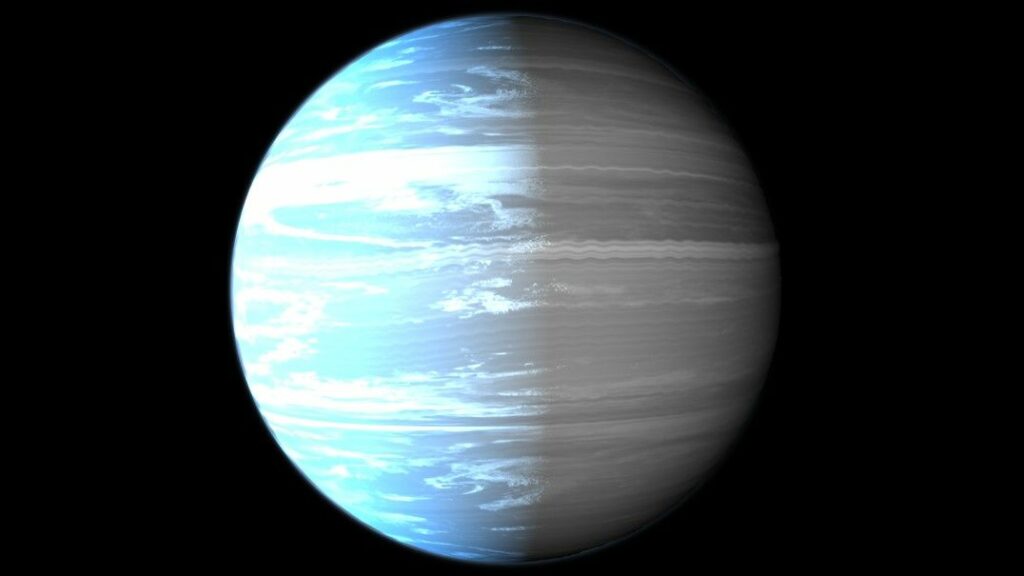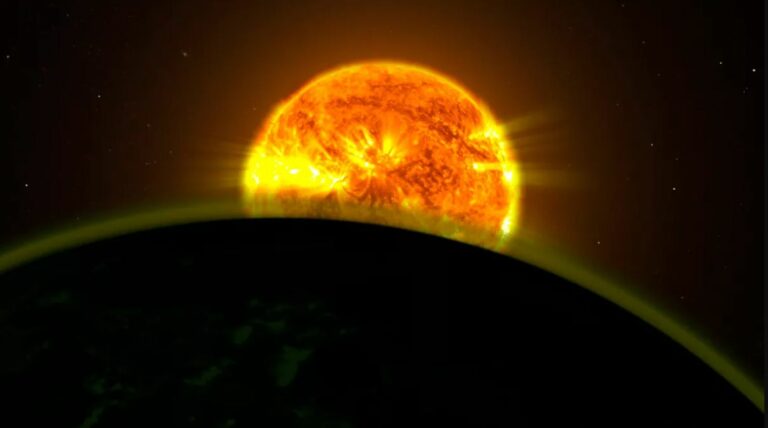Giant ‘Hot Jupiter’ Devours and Consumes Mercury-Sized Neighbor
The scorching exoplanet WASP-76 b continues to astound scientists with its extreme temperatures reaching a blistering 4,350 degrees Fahrenheit (2,400 degrees Celsius). In a recent study, astronomers delved deeper into this inhospitable world and made a surprising discovery: the planet’s atmosphere contains remnants from its vanished neighboring planet.
While heatwaves on Earth can be uncomfortable, the conditions on WASP-76 b are on an entirely different level. Researchers examined the exoplanet, known for its iron-vaporizing temperatures, and identified the presence of 11 chemical elements within its atmosphere. Astonishingly, some of these elements, essential in the formation of rocks, have yet to be detected in the gas giants of our own solar system, such as Jupiter and Saturn.
Lead scientist Stefan Pelletier, Ph.D., from the Université de Montréal Trottier Institute for Research on Exoplanets, expressed the significance of this finding, stating, “Rare are the moments when an exoplanet hundreds of light years away provides us with knowledge that would otherwise be nearly impossible to attain about our own solar system. This study is one of those moments.”

Situated approximately 634 light-years away within the Pisces constellation, the peculiar planet known as WASP-76 b owes its astounding temperatures to its close proximity to its parent star. This exoplanet, categorized as an “ultra-hot Jupiter,” resides at a distance just one-twelfth that of Mercury to the sun in relation to its own star, WASP-76.
This unique proximity grants WASP-76 b distinct characteristics. Despite having a mass around 85% that of Jupiter, the exoplanet is nearly twice as wide as the gas giant in our solar system and boasts a volume approximately six times greater. Such size expansion is a consequence of the planet being “puffed out” by intense radiation emitted by its star.
Since its discovery through the Wide Angle Search for Planets (WASP) program in 2013, WASP-76 b has been subjected to thorough examination. Scientists have successfully identified various elements present within its atmosphere. Notably, in 2020, the revelation emerged that iron on the side of the tidally-locked planet perpetually facing its star becomes vaporized and is subsequently transported to the comparatively cooler “night side,” where it condenses and falls as iron rain.
Motivated by the previous studies on WASP-76 b, Stefan Pelletier and the research team sought to acquire fresh observations using the high-resolution optical spectrograph known as MAROON-X, mounted on the 8-meter Gemini North Telescope situated in Hawaii as part of the International Gemini Observatory. This cutting-edge technology facilitated an unprecedented analysis of the ultra-hot Jupiter’s composition.
The extraordinary temperatures on WASP-76 b cause elements such as magnesium and iron, which would typically form rocks on terrestrial planets like Earth, to vaporize instead. Consequently, these elements linger as gases within the exoplanet’s upper atmosphere.

Studying this celestial body offers astronomers an unprecedented opportunity to gain valuable insights into the presence and abundance of rock-forming elements within the atmospheres of massive planets. In the case of colder giants like Jupiter, these elements are situated at lower atmospheric levels, rendering them undetectable.
During their investigation of WASP-76 b, Pelletier and his colleagues made a remarkable discovery. They found that the concentrations of elements such as manganese, chromium, magnesium, vanadium, barium, and calcium closely match not only the abundances observed in the exoplanet’s own star but also those found in our Sun.
These elemental abundances are not random; they result from the fusion of hydrogen and helium through successive stellar generations over billions of years. Stars generate heavier elements until they deplete their nuclear fusion fuel, culminating in a supernova explosion that disperses these elements throughout the cosmos. The liberated materials then serve as the building blocks for subsequent stars, while the remaining matter forms protoplanetary disks surrounding these nascent stars, eventually giving rise to planets. As a result, stars of similar ages exhibit similar compositions, characterized by consistent abundances of elements beyond hydrogen and helium, commonly referred to as “metals” by astronomers.
However, the formation of terrestrial planets like our own involves more intricate processes, leading to distinct abundances of heavy elements compared to their host stars. The fact that the new study indicates WASP-76 b shares a comparable composition with its star implies that its composition aligns with the protoplanetary disk from which it originated. This finding could potentially apply to all giant planets, highlighting the role of protoplanetary disks in shaping their compositions.

However, not all findings regarding the composition of WASP-76 b turned out as anticipated. The research team identified a peculiar phenomenon: certain elements in the planet’s atmosphere seemed to be “depleted.”
“Interestingly, the elements that appear to be absent in the atmosphere of WASP-76 b are precisely those that require higher temperatures for vaporization, such as titanium and aluminum,” noted Pelletier. “On the other hand, the elements that matched our predictions, like manganese, vanadium, or calcium, vaporize at slightly lower temperatures.”
The team interpreted this depletion as an indication that the composition of the upper atmospheres of gas giant planets is temperature-sensitive. Depending on the temperature at which an element condenses, it will either exist as a gas in the upper atmosphere or be absent because it has condensed into a liquid and sunk to lower layers. When located in the lower atmosphere, the element cannot absorb light, leading to its characteristic “fingerprint” being absent in observations.
“If confirmed, this finding would imply that two giant exoplanets with slightly different temperatures could exhibit vastly distinct atmospheres,” explained Pelletier. “It’s comparable to two pots of water, one at -1°C frozen and the other at +1°C in a liquid state. For instance, calcium may be observable on WASP-76 b but potentially absent on a slightly cooler planet.”
The team also made another significant revelation regarding the planet’s atmosphere: the presence of a chemical compound called vanadium oxide. This marks the first detection of this compound in the atmosphere of a planet beyond our solar system. Astronomers are particularly interested in this discovery as vanadium oxide can have a substantial impact on hot giant planets.
“This molecule plays a role similar to ozone in Earth’s atmosphere: it efficiently heats up the upper atmosphere,” clarified Pelletier. “Consequently, temperatures increase with altitude, contrary to the typical temperature decrease observed in colder planets.”
In addition, the team made an intriguing observation of an elevated concentration of nickel surrounding WASP-76 b, surpassing initial expectations. This finding suggests a possibility that the gas giant planet might have engulfed a smaller rocky world akin to Mercury, which contained a significant amount of this element, at some point in its history.
The astronomers responsible for these breakthroughs will continue their investigations of this exoplanet and similar celestial bodies, aiming to unravel the influence of temperature on atmospheric composition. Along the way, the team expressed their aspirations that the knowledge gained from these studies can be applied to gain insights into giant planets closer to our own solar system.
The research is described in a paper published on Wednesday (June 14) in the journal Nature.
Do not forget to share your opinion with us to provide you with the best posts !




0 Comments